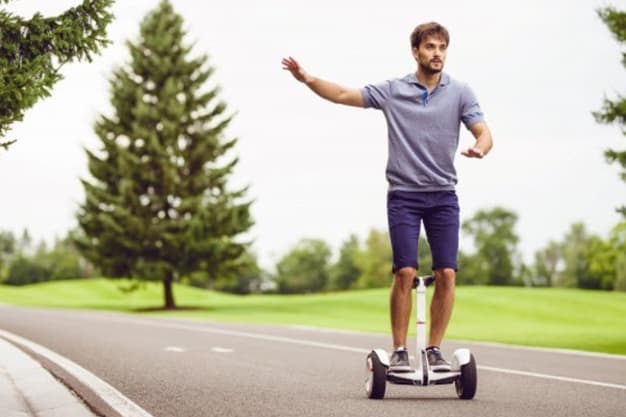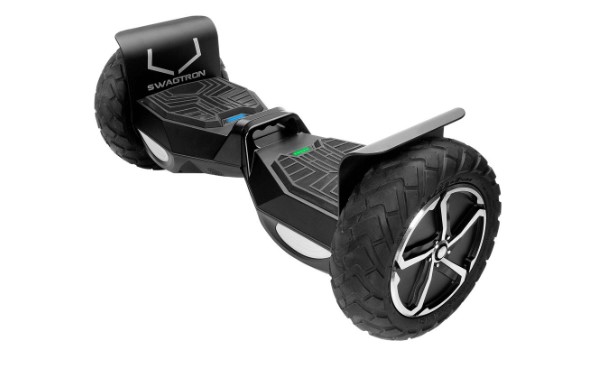How Much Do Hoverboards Weigh? (It May Not Be as Heavy as You Think)

If you are curious about hoverboards and want to get in on with the action, there are a few significant things that you need to know, such as the weight of a hoverboard. Sometimes, hoverboards weigh more than electric skateboards or weigh as much as electric scooters.
The average weight of a hoverboard is around 25 lbs, which is almost twice the weight of a mini electric skateboard. Smaller hoverboards for kids weigh at around 20 lbs while the heavier ones with bigger wheels weigh about 30 lbs.
Why does it weigh that much for something small in size? Let’s find out in the next sections of this guide.
How Much Does a Hoverboard Weigh? Hoverboard Weight Range
It seems impossible for brands to make a lightweight hoverboard because several heavy components make up a board. The lightest option weighs around 20 lbs. Although most adults don’t mind carrying a 20-pound board, younger kids will probably find it too heavy for them.
To make these hoverboards handier and easier to carry, many companies are also selling carrying bags separately. Some boards like the Swagtron T6 is equipped with a carrying handle. Having a carrying handle makes the board easier to carry, but it can still take its toll on you if you carry it for a long time.
A lighter hoverboard is most likely equipped with a smaller motor, meaning it cannot go as fast as a heavier board with a massive motor. Heavier boards tend do be faster because of the battery and motor size, which is why faster boards seem to be heavier than regular hoverboards that are commonly used for riding smooth surfaces only.
Off-road hoverboards have more reason to be heavier. The wheels themselves are a third of the overall weight. So, if you are looking for a lighter option, choose a board with smaller wheels.
However, small wheels are not recommended for rough road terrain. For this reason, expect the board to have bigger wheels and could weigh above 25 lbs if you are after a model that is for adventure riding.
Some manufacturers shave off weight by using lighter materials, but they cannot compromise the rest of the components because doing so affects the hoverboard’s performance.
What Features Affect Hoverboard Weight?
Here are some of the features that affect the overall hoverboard weight aside from the size of its tires:
- Hoverboard Size
Hoverboards come in different sizes to make sure there is something for everybody, no matter what the rider’s height is. If a rider chooses a hoverboard that might be too small or too big, they will have a hard time maneuvering and controlling the hoverboard, which can be hazardous.
- Extra Features
Extra features such as Bluetooth speakers and LEDs can also affect the weight of a hoverboard. Even though these features do not weigh that much, they still contribute to the overall weight when combined. The good thing is, these features are just optional and do not necessarily affect the main function of the hoverboard. So buyers can decide to skip the extras if they want a lighter hoverboard weight.
- Materials Used to Build the Hoverboard
The type of material used to build a hoverboard significantly affects how much a hoverboard weighs. When looking for a hoverboard, you will come across materials such as ABS plastic (1), aluminum, magnesium alloy, and many more. A board that is made out of plastic is probably the lightest, but this material is not as durable as the others.
- Hoverboard Battery
The size of the battery affects the hoverboard weight. Reducing the size of the battery will most likely reduce the range and power output as well, which means riders will not be satisfied with the outcome because ride time may be cut short.
- Motor
The motor is one of the most integral parts of a hoverboard, which is why reducing the motor size will significantly affect the capacity of the hoverboard to carry heavy riders and the capacity to ride uphill and through different terrain.
There is not a lot of ways to reduce the weight of a hoverboard without affecting its performance. The only thing you can do is to get used to it and accept that hoverboards average at this weight.
Why Hoverboard Weight is Important
The hoverboard weight affects how riders ride a hoverboard. A heavier board will need more force to respond, and lighter people may have a hard time controlling a heavier board, especially when turning.
The weight of the board can determine if it’s a good board or not. If you come across a heavy board, expect it to have a fast motor with a farther range. If the board is heavy and the board is slow, it means the right kind of components are not added to it.
Heavier hoverboards tend to gain more speed and momentum, making the board run much faster, especially when going down mild hills.
Tips on Traveling with a Hoverboard
To make traveling with the board easier makes sure you always ride the board when you can, as this reduces the amount of weight you need to carry. Instead of carrying the hoverboard, let the board carry you.
To lessen the weigh on your shoulders, you can also opt to purchase a carrying bag. The board will still be heavy, but a carrying bag certainly helps. If the battery runs out in the middle of your ride, you will have to carry the board to get to a charging spot. So, having a bag truly helps.
Rider Weight

If the rider is too heavy for a light hoverboard, the rider must choose a more powerful hoverboard Some hoverboards such as the Swagtron T6 weighs only 30 lbs, but it can carry more than 10 times its weight.
Conclusion
The weight of a hoverboard should not be compromised, but you can find the right balance between weight and performance. After all, there is something for everybody when it comes to hoverboards.
References
zippyelectrics.com may earn commissions when you purchase items through links to external source such as Amazon. Read our affiliate disclosure here.

